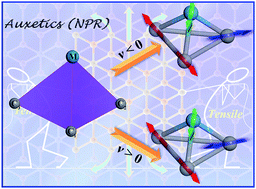Highly negative Poisson's ratio in a flexible two-dimensional tungsten carbide monolayer†
Abstract
Auxetic materials have numerous promising engineering applications such as fracture resistance and energy storage due to their negative Poisson's ratios (NPRs). However, compared to materials possessing positive Poisson's ratios (PPRs), auxetic materials are rare. In this paper, by employing first principles calculations, we found a high NPR two-dimensional (2D) material, tungsten carbide (W2C), in the transition metal carbides (MXenes). Our results of the relatively moderate Young's modulus and fracture strength as well as the critical strain showed that the 2D monolayer W2C is an extraordinary flexible material. Our DFT results also demonstrated that W2C possesses high NPRs while Hf2C and Ta2C have PPRs. Furthermore, the mechanically induced deformation mechanism and the NPR formation mechanism of W2C have been proposed. Such an intrinsic NPR in W2C is attributed to the strong coupling between the C-p and W-d orbitals in the pyramid structural unit. The mechanically induced deformation mechanism and the PPR formation mechanism of Hf2C have also been determined. The intrinsic NPR for W2C transforms to PPR upon the surface functionalization induced. The behavior occurs due to the W–C interaction weakening. The excellent NPR in the 2D MXene material combined with other outstanding properties such as the metallic state would bring about its promising engineering prospects, ranging from the metal-ion battery, to automobiles and aircraft.



 Please wait while we load your content...
Please wait while we load your content...